#parasitoid egg
Text
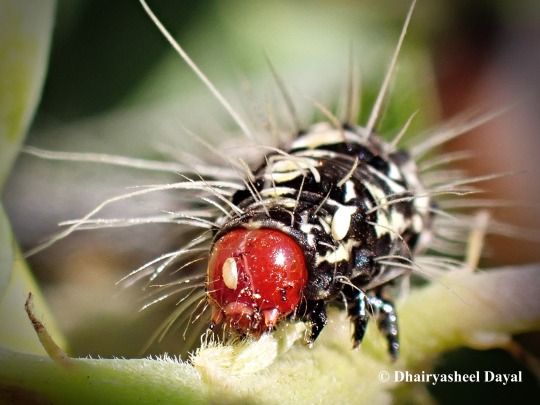
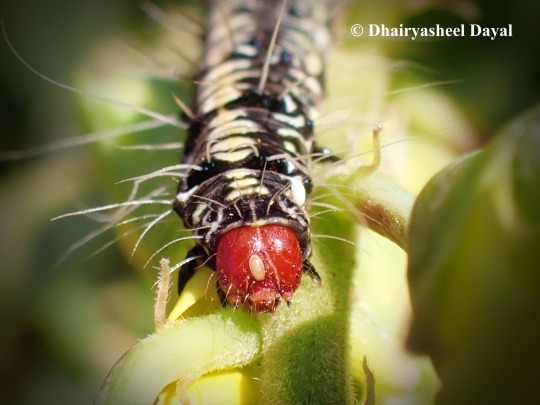

Uncertainties, and Lucky to be Alive:
We often talk about how human life expectancy has increased over the years. But, the quality of life in some parts of the world, even today, continues to be of degraded nature. And the uncertainties in life in these populations too is high. These regions are conflict zones, or those facing risks from climate change and global warming. And when it comes to thinking about the end of humanity, people may think that it is either far away, or if it is to happen suddenly, then it will be due to an event - such as asteroid impact.
But, do we think about lives of plants and animals, or of any other species -our fellow earth companions - say a particular insect?
For an example, consider this creature in the photo, which is a moth caterpillar. And those structures which you can see on its eyes and another on its frontier (near eyes) is an egg laid by another species of an insect (a parasitoid). So, this caterpillar mostly won't be surviving. Apart from chances of being eaten by some insect, what are other things that can happen with this caterpillar? Yes, it can be killed by a bird. Or it can be captured and killed by human, for the purpose of learning/ science. Or it can be carried away by a sudden stream of water in its area; flown off by strong wind. Its host - plant, and other plants nearby may die, causing this caterpillar to die too. Thunderbolt may strike and make it disappear. And there are so many possibilities by which this caterpillar may die (we are not considering its adult form - an adult moth).
How lucky we the creatures of this earth are to manage to survive and fend death every single day. Or how unlucky we are to be slave to the possibilities by which which we could die, and to face uncertainties in life.
- Dhairyasheel Dayal
#ecology#insect insect interaction#parasitoid egg#insect egg#insects#life#life on earth#struggle for survival#zoology#biology#entomology#short articles#moth caterpillar#caterpillars#moths#western ghats#insect photography#photography#macro photography#macro
8 notes
·
View notes
Photo
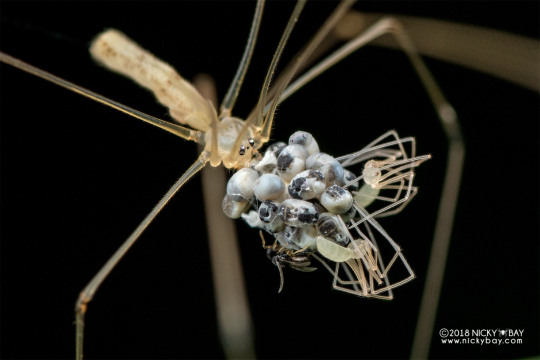


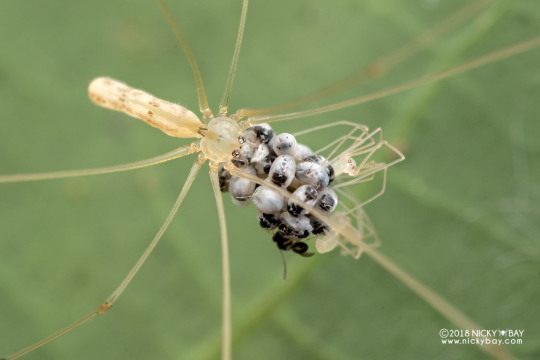
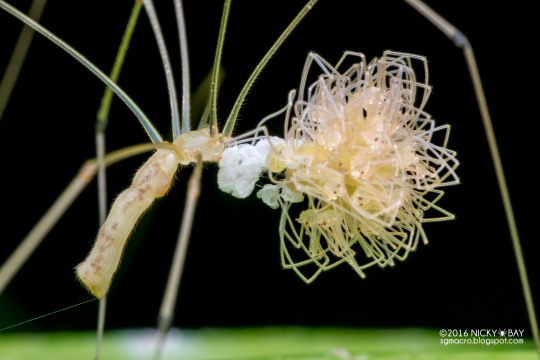
Cellar spider, Leptopholcus podophthalmus, Pholcidae
Female cellar spiders hold their egg sac in their mouth parts until they hatch - in these photos, the spiderlings are in the process of emerging. Also featuring a very tiny parasitoid Scelionine wasp visible in photos 1-4.
Photos by Nicky Bay // Website // Facebook
Shared with permission; do not remove credit or re-post!
#animals#curators on tumblr#bugs#arachnids#spider#cellar spider#wasp#parasitoid#scelionine wasp#spiderlings#eggs#congregation#one nice bug
492 notes
·
View notes
Text


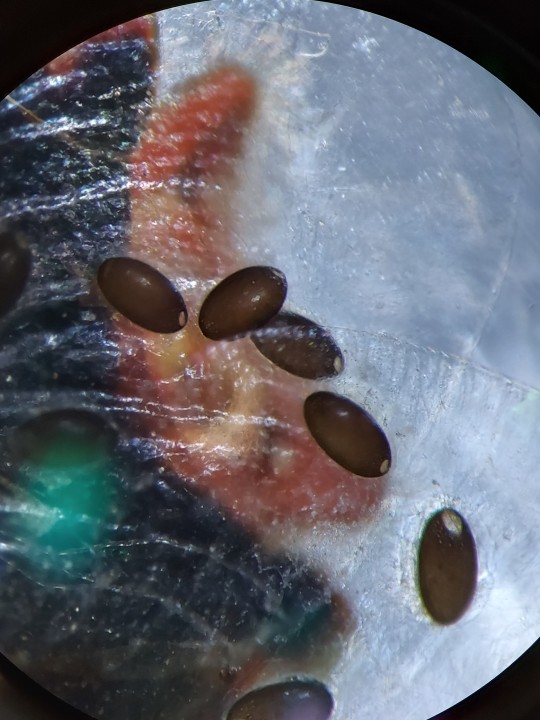
mystery eggs on this shield bug's hemilytra
49 notes
·
View notes
Text


^ this one fucks up cockroaches and the other ^ fucks up ladybugs
#gamer txt.#insects#bugs#wasps#its only these because i like these two especially but Alot of wasps are parasitoids and fuck up other bugs like this i just like these two#i also think dinocampus coccinellae is unique in using ladybugs to guard their eggs i think alot of wasps Just use their bugs as baby food#i know the enerald cockroach wasp looks fun and is better known but im letting you know the little guy is cool too
32 notes
·
View notes
Note
*looks at the bug next to you* um

thats my SON donbt be RUDE
#bugs#asks#hi toonny i love youuu#also this is a Baeus sp. Wasp for those who dont know =.3#theyre a parasitoid type that puts their eggs in spider eggs!
4 notes
·
View notes
Text
sometimes you just gotta break down and make the damn Wikipedia page
#this is for all my enjoyers of the genus Baeus out there#I'm going to find every goddamn source i can and I'm going to give you every damn thing I've got#I'm going to learn how to format on Wikipedia from the ground up or so help me#mine#Wikipedia#listen to me. come closer#*whispers* Baeus is an extremely cute genus of parasitoid wasps#they look like roly-polys#and they parasitize spider eggs#and I LOVE THEM
2 notes
·
View notes
Text
Re-edit of Die Hard where all the guns are infrared lasers that rapidly incubate the eggs of parasitoid creatures already inside the bodies of the characters.
This would be relatively easy to accomplish: the 'bullet' sfx could be replaced by a gentle humming sound and some of the lines of dialogue said to John over the radio could be dubbed to mention the parasitoid creatures in passing, and the various encounters the characters have had with their needle-like ovipositors that filled their bodies with menacing roe.
#die hard#christmas#eggs#edit#sfx#parasitoid#bruce willis#hans gruber#roe#movies#action#hans gruber has a zoology degree in the bevavioural ecology of the creatures and drops facts about them instead of suits
3 notes
·
View notes
Text
god the arc in space was good
#haven't seen it in over a decade#but like. conceptually#the way it differentiates itself from its successor(?) alien by the wirrn being played more as#literal BROOD parasitoids#with the remains of humanity being stuck in stasis functioning like a hive of sorts#brood pararistoid used colloqially#i'm referring to the common wasp thing of laying eggs in the grubs of another species rather than the adult. not kleptoparasitism or#that shit cuckoo wasps get up to#<- has been reading wikipedia#god i love wasps and bees and sometimes ants so much but i. don't really have a 'well' to infodump from as deep as some do#its like. the 'arc' as it exists in the serial is basically a vault filled with hermetically frozen humans who fled the irradiation of the#planet to hibernate in space. leaving them like functionally ungarded but still-cared-for-(by-life-support-and-shit) wasp/bee larvae#(ungaurded because why the fuck would technologically advanced but not really aliens-trained humanity predict 'space wasps')#its a fuckin buffet of new hosts lmfao#'i dont care if i do' ass shit#i'm sure i'm getting minor details wrong maybe most of the humans are already dead or some bs idk its been like 15 years#also then again maybe theres a lotta frozen people in Alien too? idk i still haven't fucking seen it bc i never just watch movies i mostly#associate that movie with people hiding from the thing or getting ambushed though (or being gruff military dudes and just shooting them wit#guns. thanks randy and also the second flick allegedly.)
0 notes
Text
It’s a fly-eat-fly world out there… in the sandy scrubland of central Florida, a hanging thief robberfly (Diogmites esuriens) devours a beefly (Exoprosopa fascipennis).
Interestingly enough, the beefly is a parasitoid that lays eggs in the nests of sand wasps (Bembix), which are themselves specialist hunters of flies including both beeflies and robberflies (though I’m not sure whether this hanging thief is too formidable to be on the wasps’ menu). Insect food webs are amazingly convoluted.
(9/30/23)
#flies#asilidae#bombyliidae#diptera#bugblr#bugs#insects#entomology#hanging thief#Diogmites#Exoprosopa#beeflies#robberflies
613 notes
·
View notes
Text
Something people might be interested in since my friends didn't know: there's this little parasitoid wasp, Copidosoma (Encyrtidae) that has larvae with castes, like ants!
Copidosoma is a polyembryionic wasp, which means many larvae can emerge from a single egg, which in their case is laid in caterpillars. The cool part is that some of these larvae are neither male nor female, but sterile workers that will never become adults, and only exist to defend their siblings by attacking competing larvae chemically AND physically.
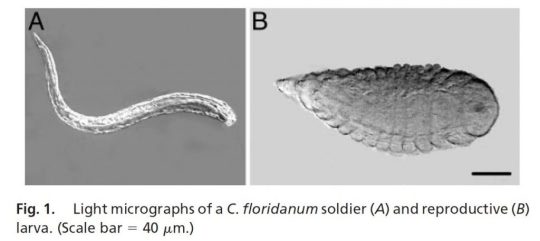
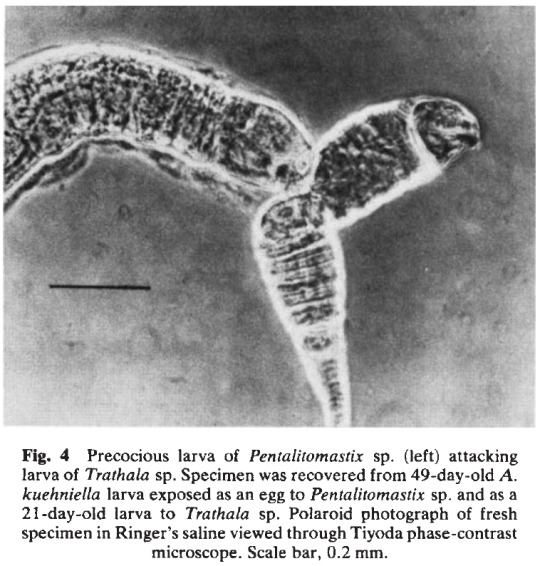
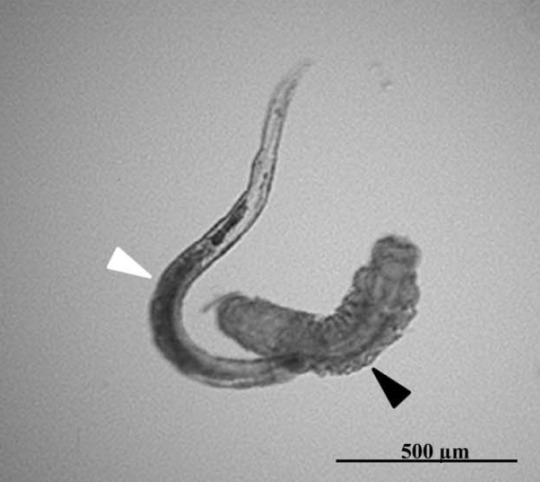
In these photos you can see the slender, sexless soldier larvae, and the more typical looking reproductive grub, plus two example images of the soldier attacking larvae of competitor species. Again all this happens inside the eggs and bodies of caterpillars! These things aren't even rare, my boss did his dissertation on this family and described them as "common as dirt". They're used in pest control as a natural enemy. This is a very common species that exists all over the world, almost entirely unnoticed because they're just so small and inconspicuous.
They're not even the only parasitoids that have hit on this either, here's a slide I enjoyed from a PowerPoint I saw at the national ESA meeting. Tragically I have forgotten the authors of this presentation tho..

Update: this paper is about competition between braconids Cotesia glomerata and rubecola and is not the same thing as what's going on in Copidosoma, but does still involve baby on baby violence in the flesh of a living caterpillar.
931 notes
·
View notes
Text
When your life cycle is so ridiculously complex, that it's a miracle you exist. Trigonalid wasps are super weird, but also very interesting. They are hyperparasitoids. The female will lay thousands of eggs on foliage, with the intent of the eggs being ingested by a herbivorous host, like a caterpillar. Once the eggs are consumed, they will hatch and attack any already inhabiting primary parasitoid host, like a Tachinid fly or Ichneumonid. It doesn't end there. Some Trigonalid wasps are parasitoids of Vespid wasps, and for their continued survival, the original host (caterpillar), must be brought back to the nest where it is fed to a Vespid wasp larva. The larva consumes the caterpillar and Trigonalid larvae that are inside and becomes parasitized. The individual presented in my drawing is based on Taeniogonalos gundlachii. There are probably other animals out there with even more complex life cycles! As far as wasps go, I'd consider this survival strategy to be very intricate.
I have added a chart that explains the phenomenon.
In the latter case, the caterpillar full of Trigonalid eggs would be preyed on by a Vespid wasp and brought back to the nest. Once fed to a Vespid wasp larva, the remaining Trigonalid larva then consumes the host.
https://www.researchgate.net/figure/A-diagram-describing-the-life-stages-of-the-trigonalid-hyperparasitoid-Orthogonalys_fig1_221959174
https://www.researchgate.net/publication/221959174_A_Scattershot_Approach_to_Host_Location_Uncovering_the_Unique_Life_History_of_the_Trigonalid_Hyperparasitoid_Orthogonalys_pulchella_Cresson#pf2



#hymenoptera#insect#entomology#wasp#wasps#apocrita#cartoon#Trigonaloidea#Trigonalidae#Taeniogonalosgundlachii#Hyperparasitoid#parasitoid#comic#parasitica
797 notes
·
View notes
Photo

Spun glass slug moth caterpillar (Isochaetes beutenmuelleri) with attached cocoons from parasitoid wasps
Parasitoid braconid wasps will lay eggs on or into host caterpillars. The eggs hatch and the wasp larvae live inside and feed on the caterpillar’s body. The larvae then emerge and spin a cocoon attached to the caterpillar to pupate inside. The host caterpillar is usually killed, though sometimes they manage to pupate first.
Photo by lyndawill777
#animals#curators on tumblr#insects#bugs#caterpillar#moth#larva#slug moth caterpillar#slug moth#spun glass slug moth#parasite#parasitoid#wasp#braconid wasp#bug death#one nice bug
519 notes
·
View notes
Text
Bomber Flies: these flies launch their own eggs into the nests of wasps and bees, hovering in mid-air as they do so; the females also have a unique perivaginal pouch that is known as a "sand chamber" because it is filled with sand

Above: Anastoechus sp. (top) and Anastoechus nitidulus (bottom)
The flies of this family (Bombyliidae) are generally referred to as "bee flies," because they are known to mimic bees and bumblebees, but many of them are also known as "bomber flies," thanks to their unusual ovipository technique.

Above: a bomber fly of the genus Anastoechus
As the female bomber fly is preparing to lay her eggs, she will usually look for a soil-hidden nest that already contains the eggs/larvae of another insect. Most bomber flies lay their eggs in the nests of wasps and bees, but there are a few species that are known to target beetles, grasshoppers, locusts, other flies, and/or caterpillars, instead. Once the bomber fly has found a suitable nest, she will hover over the entrance to the burrow and rapidly flick her abdomen up and down until she has launched a single egg into the nest. She must then go searching for more nests in which to lay her other eggs.

Above: Anastoechus sp.
After hatching, the parasitoid larvae of the bomber fly feeds on the eggs/larvae of the host species (i.e. the nest's original occupants). As this article explains:
When a bee fly egg hatches, a tiny larva called a planidium emerges. The planidium is quite unlike most fly larvae (also known as maggots); they are adapted for moving quickly in search of a host. Once the planidium finds a host, it will attach itself to the host’s exterior, like a leech or sea lamprey, and begin to feed. Yes folks, this is the stuff of nightmares.
Female bomber flies also have another peculiar trait: their abdomen contains a specialized perivaginal pouch known as a "sand chamber." During the ovipository process, the fly fills this pouch with fine grains of sand, and her eggs are then coated in the sand as they pass through the perivaginal pouch. The pouch is also lined with elongated setae ("hairs") and enlarged spikes that prevent the grains of sand from spilling back out.
The overall purpose of the "sand chamber" is still unclear, but many researchers believe that coating the eggs in a layer of sand may help to improve the viability of the eggs by preventing them from being damaged as they are launched to the ground, and that it also provides them with some camouflage after they have landed. Some researchers have argued that it prevents the eggs from becoming dehydrated, because the barrier helps to improve fluid retention, while others believe that it improves the mother's aim by increasing the weight of each egg. There is some evidence to suggest that it could also prevent the eggs from being detected (and then destroyed, abandoned, or ejected) by the host species, because the sand helps to mask/mute the egg's biochemical signals.

Above: Anastoechus barbatus
Adult bomber flies tend to feed on pollen and nectar. They are excellent pollinators, and their parasitoid larvae may also help to keep wasp and bee populations in check.

This article notes that bee flies (particularly Anastoechus nitidulus) likely served as the inspiration for the Pokémon known as cutiefly:

Sources & More Info:
USGS: Bombyliidae Fly
Biological Journal of the Linnean Society: The Evolutionary Pattern of Host Use in the Bombyliidae (Diptera) Family
YouTube: Video of a Bomber Fly (Bombylius major) Selecting a Nest and then Launching her Egg into the Burrow
Smithsonian Institution Press: Bee Flies of the World (pages 6 and 27)
Michigan State University: Bee Flies
Animal Diversity Web: Genus Bombylius
Animal Diversity Web: Anthrax albofasciatus
Journal of Geek Studies: The Entomological Diversity of Pokémon
#entomology#diptera#hymenoptera#insects#bombyliidae#bombylius#bomber fly#nature is weird#anastoechus#bee fly#flies#bugs#biology#arthropods#cute animals#animal facts#pokemon#cutiefly#weird bugs#no matter how bad my period gets#at least I can take solace in the fact that I do not have a “sand chamber”
196 notes
·
View notes
Text
Okay, entomology brain is annoyed by a Tumblr ad
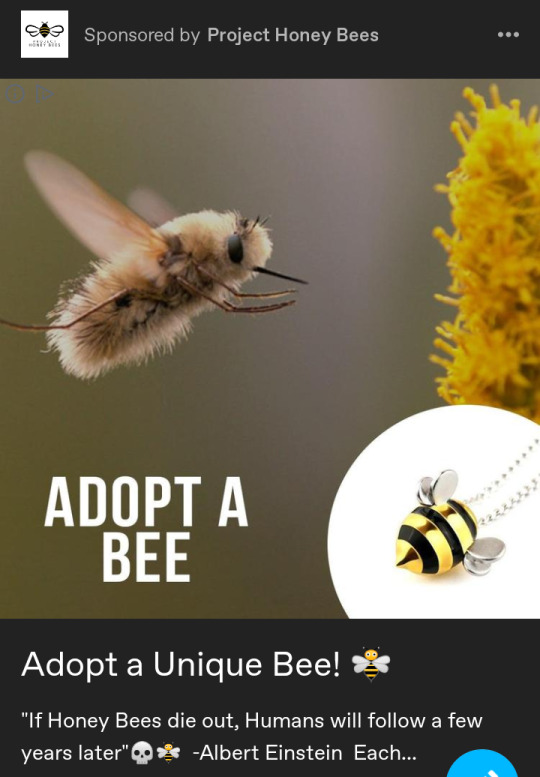
Specifically, this one. First, Albert Einstein never said that.
Secondly, and more importantly, that is NOT a honey bee, or even a bee at all. That is a bee fly, a very important, very cute pollinator. However! They have parasitoid larvae! This means that they lay their eggs in the larvae of other bugs. Those eggs hatch, and those larvae eat the bug they're in from the inside out. Sounds horrible, but it's the way of things and I cannot understate how important these guys are.
The reason I'm annoyed about the picture of choice isn't even that they didn't picture a bee (not even in the right order- bees are hymenopterans. Flies are diptera.) What's really grinding my absolute gears about the choice here? Bee flies parasitize bee larva.
If you're going to use the wrong picture, at least don't use the picture of something that actively kills what you're trying to protect instead of the animal you're protecting.
Also, honeybees, Apis mellifera, don't need protection. They're fine. They're invasive in North America, even. Humans take care of them just fine. I'm a beekeeper, and I love them, but that's not where our efforts should be. We should be trying to protect native bees, there are a whole bunch that I bet you've never heard of that need help.
Anyway, rant over. Sorry, I just could not let that one go.
#honey bees#save the bees#entomology#environmental things#endangered species#ground bees#bumble bees#wasps#was gonna q this but fuck it im posting it now and ill srb tomorrow
4K notes
·
View notes
Note
Honest question from someone who also dislikes "invasive species control that amounts to kill on sight": what do you suggest as an alternative control effort should I encounter say a spotted lanternfly or a spongy moth? I really hate just killing bugs for being in the wrong place. Thanks!
i honestly don't think there is much that any individual person can do. like in general once an exotic species has established in an area there's almost nothing short of a fast and concerted multimillion dollar years-long eradication program that even stands a chance of actually removing them entirely. and this is a rant for another day but generally nobody wants to pay for the kind of program that stands an actual chance of being successful. it doesn't matter how many concerned citizens you convince to go around smashing animals, if even a handful get missed, and many many more than a handful will get missed, the survivors can lay enough eggs and rapidly enough that the population will have no trouble rebounding. the way to eradicate an invasive species, when it's even possible, is through very strategic and large-scale application of pesticides, environmental control, parasitoids, and other integrated pest management strategies.
and that's not even mentioning that the whole smash-on-sight thing requires people to recognize the target and not just smash every bug they see which is also another rant for another day because you would not fucking believe how bad people are at identifying insects like i've had fucking crane flies reported as "murder hornets" (another rant). i genuinely believe that entomology should be a core primary and secondary education subject alongside history and math. the world is mostly bugs and it's important to know at least a little about them. without mass knowledge, the whole campaign just engenders a further generalized fear and disgust and violence towards all insects which is fucking nasty to me.
anyway i'm getting distracted. back to your question, what should you do if you encounter a spotted lanternfly or spongy moth or japanese beetle or whatever? report it to your state's department of agriculture if you live in the united states, or to whatever the equivalent is if you live elsewhere. chances are they're already aware of the infestation in your area but there's always the chance that they're not. with any luck they're one of the few ones that actually has the funding to operate a large-scale control program and are working on it already. again i'm very fatalistic about these things and don't think that eradication is possible in most cases by the time the exotic insect is discovered but at the very least it is often possible to keep the populations in check to the point that they're not an ecological/economic catastrophe using the IPM methods mentioned above--with enough funding. you can kill the bug if you want but smashing one bug or a dozen or a hundred or a thousand isn't going to do shit in the long run or the large scale and it's not the bug's fault that it is where it is.
761 notes
·
View notes

